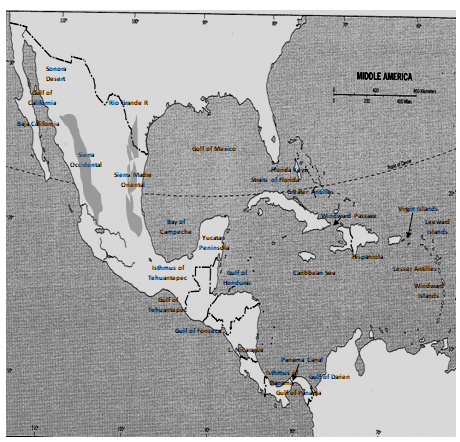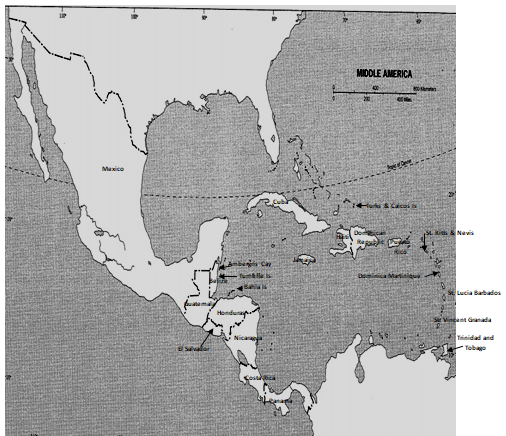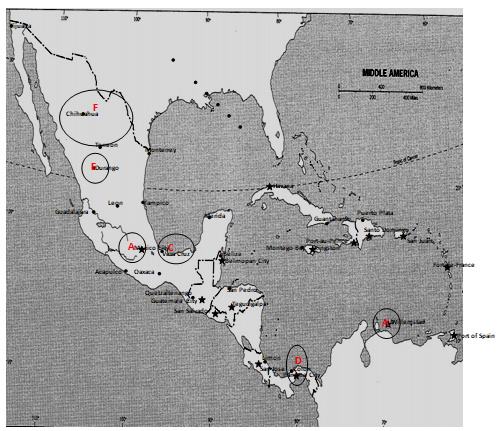Map comparison
As portrayed by the map of Central America characterized by varied climatic conditions, it is apparent that the physical geography of this region has played a big role responsible in modifying the climatic conditions of the same. As such, the climatic conditions of specific regions offset each other displaying unique climatic conditions to totally unique regions.
Basically, the Northern part of Central America is characterized by arid and semiarid climatic conditions with precipitation not exceeding 50 mm. However, with the presence of Plateau of Mexico that cut across this region the climatic conditions has greatly been modified. As such, just on the plateau the region is typified by highland climate that receives rainfall not exceeding 200 mm (Schaefer 302).
Generally, with the presence of a plateau we expect the immediate, adjacent land masses to experience distinct climatic conditions on either side of the same. To this end, one side i.e. the windward side is expected to receive considerable precipitation relative to the other side.
However, for the Plateau of Mexico a totally different climate is observed; it is bordered by arid and semiarid climates even though there is a presence of a water body (Pacific Ocean) on its left.
As the land mass narrows down to the South the presence of ocean currents on either side of the land is the reason behind the climatic conditions. This region is characterized by humid equatorial climate receiving rainfall above 200 mm.
From figures 4-5 and 4-6 of the map of Central American geographical region, one can clearly distinguish between the Mainland and Rimland regions. In essence, these two regions are distinct in both cultural and economic fronts. As regards cultural composition, the Mainland is composed Euro-Amerindian cultural group of Spanish origin that stretches along the western coastal strip to the larger Mexican state.
In the contrary, the eastern costal strip stretching to the coastal strip of Costa Rica and, the Caribbean islands are mostly dominated by Euro-Africans mainly of British, French and Dutch origin. Basically, the population composition is a consequence of slave trade that characterized the region in the early 18th century owing to a dwindling Amerindian population.
As regards economic front these regions exhibit utterly dissimilar characteristics. In particular, the agricultural sector is totally different. The Rimland region is distinguished by plantations that grow one type of crop while the Mainland is distinguished by hacienda. Moreover, as opposed to the Rimland the Mainland produce is meant for export and hence largely affected by fluctuating world market prices (MacLeod 678).
The eastern coast just like the Caribbean islands which is typified by plantations (sugarcane and bananas) was initially inhabited by Britons and as such it is distinctively a Rimland region. As regards the origin of the current cultural composition of Central America most of them trace back to their respective colonialists. For instance the Jamaicans speak English and owe much of their culture to Britons their former colonialist.
The same goes to Haiti nationals who share a lot with French. Also, the Mexicans share a lot with Spaniards, and the descendants of a cultural fusion between the Spaniards and Amerindians- the Mestizo are common in Mexico. The majority of Cuban nationals are Hispanics, and Cuba as an area is almost equal to the entire total area of Caribbean islands.
On a closer look at the maquiladoras (multiple factories) as portrayed by figure 4-11 most of them are located on the northern states of Mexico bordering the US. Strategically located are maquiladoras which are closely located to the raw materials, and closer to the US border. The essence of having the factories closer to the US border is because the finished products are exported back to the US and Canada.
The owners of these factories are foreigners and hence benefit from Mexicans’ cheap labor. On the other hand the Mexicans benefit through job creation, new technology and foreign investment (Kimble 606).
Map 1: Physical geography of Central America

Map 2: Names of Republics

Map 3: urban-economic information


Works Cited
Kimble, Hebert. “The Inadequacy of the Regional Concept” London Essays in Geography 2.17 (1951): 601-617. Print.
MacLeod, George, and Jones Mother. “Renewing The Geography of Regions.” Environment and Planning 16.9 (2001): 669-800. Print.
Schaefer, Frankline. “Exceptionalism in Geography: A Methodological Examination.” Annals of the Association of American Geographers 43.3 (1953): 298-305. Print.